|
Hinduism
Understanding Hindu Dharma, national culture:
'Ramayanam' - it's significance
by Chelvatamby Maniccavasagar
Ramayanam which was authored by the great Hindu poet 'Kamban' is not
a history or biography. It is only a Hindu mythology. One cannot
understand Hindu Dharma unless one knowns Rama, Sita, Bharata,
Laskhmana, Ravana, Kumbakarna and Hanuman.
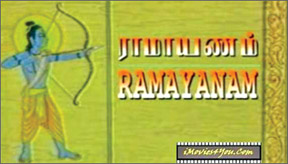 Mythology is an integral part of religion. It is as necessary for
religion and national culture as the skin and skeleton that preserve a
fruit with its juice and its taste. Mythology and holy figures are
necessary for any great culture to rest on its stable spiritual
foundation and function as a life giving inspiration and guide. Mythology is an integral part of religion. It is as necessary for
religion and national culture as the skin and skeleton that preserve a
fruit with its juice and its taste. Mythology and holy figures are
necessary for any great culture to rest on its stable spiritual
foundation and function as a life giving inspiration and guide.
Traditions of the Ramayana
Professor S Pathmanathan in his article on Sri Lanka and Ramayana
refers that the traditions of the Ramayana form an integral part of the
shared cultural heritage of India and Sri Lanka.
He says that no other religious poetic work has influenced the
thought, life and culture of the people in the ancient work as the
Ramayana. The characters of Ramayana became the repositors of valour,
virtue, spiritual insight and compassion. They exemplify the pursuit in
establishing a moral order in an imperfect world.
Annual Kamban Vizha
In fact, the Colombo Kamban Kalagam has made elaborate arrangements
to conduct its annual Kamban Vizha for four days at Wellawatte,
Ramakrishna Mission, Colombo 6, commencing from April 21 to April 24,
2011, presided by the Kamban Kalagam President T Eeswaran.
The former President of Kamban Kalagam and retired judge of the
Supreme Court C V Wigneswaran will deliver the keynote address.
Indeed, there will be several programmes including religious
speeches, debates, kavi arangam, and felicitation ceremony for those who
have tremendously contributed for the development, promotion and
propagation of Hindu religion, Tamil language and literature, epics like
Ramayana, Mahabharatha and art and culture.
Furthermore, great religious personalities and Tamil scholars from
Sri Lanka and India will participate in large numbers for this Kamban
Vizha.
Kamban Kalagam which was established by the great religious and Tamil
scholar Kambavaruthy E Jeyaraj in 1980 in Jaffna has already completed
treasured 30 years and has rendered immense service for the Tamil
speaking people, particularly younger generation who have not read or
heard about these epics like Ramayana and Maha Bharatha which teach
Dharma to lead a useful and purposeful life and to maintain tranquility,
equanimity, serenity, placidity, peace and harmony in our life.
In fact Kambavaruthy Jeyaraj is a great religious and Tamil scholar
of international repute and an accepted and acknowledge authority in
Ramayana, Mahabaratham and Thirukural. Further, he is the most sought
after speaker in Sri Lanka and abroad. He is a multi-faceted and
multi-dimensional personality with a vision, mission and foresight and
maintains humility and high degree of discipline inspite of his heavy
work.
Dedication and devotion
He is a dynamic organizer who gets the support and cooperation from
youths who always come forward to help him spontaneously to conduct this
annual Kamban Vizha to the greater satisfaction of everyone.
During the Kamban Vizha the youths participate in large numbers and
take every possible step for the success of this great religions and
literary festival in which people from all parts of Sri Lanka
participate in great numbers.
In fact, Kambavaruthy's dedication, devotion and commitment have been
immensely commended by not only great religious and literary
personalities, but even by eminent Supreme Court judges, educationists,
professors, Vice-Chancellors, great Tamil scholars, Members of
Parliament and even Ministers.
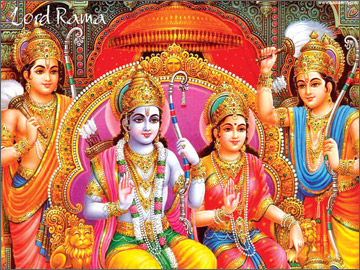 |
|
Rama, Sita,
Luxmana, and Bharatha |
Even, he has been conferred with several titles and awards for his
contribution in the literary and religious world. Further, his religious
discourses are of high standard and keeps the audience spellbound.
Kambavaruthy Jeyaraj has established a temple namely Iswariya Lucksmi
in front of the Kamban Kalagam building at Ramakrishna Garden at
Wellawatte, Colombo 6.
Furthermore, Sri Lanka had a special significance on the Ramayana
traditions.
It was the land of two principal characters namely Ravana and
Vibushana. Although brothers, they were men of opposite ways. Ravana
swayed from the path of Dharma while his brother Vibhushana was
steadfast in his adherence to the principles of Dharma.
Referring to Sri Hanuman, poet Kamban says that he represented the
most cultured youth of his time and also expressed maturity,
intelligence, alertness, calmness, smartness, nobility, courtesy - all
bundled together.
Further, Sri Hanuman is the embodiment of dedication and enthusiasm.
He created confidence in Sita's mind by telling that he is the messenger
of Rama. When he gave the ring with Rama's name engraved on it, she
gazed at it and was greatly delighted.
Sri Hanuman
Her beautiful face brightened with joy just like the moon emerged
from the eclipse and she welcoming Hanuman with affection and cheerfully
said, "You are undoubtedly clever, bold and heroic."
Further, Sri Hanuman never took credit for anything he achieved. In
fact, he even went to the extent of praising Sita. Undoubtedly virtues
are the ornaments of a cultured person. Sri Hanuman exemplified all the
good virtues and ever remained as the servant of Sri Rama.
In regard to Sita, she may appear a helpless, weak, grief stricken
person, but in truth she is an embodiment and personification of
strength.
Undoubtedly to a world lost in error and beset by perplexities,
forces of darkness, conflicts and contradictions, trials and
tribulations Kamba Ramayanam will redeem millions of people from
violence, hatred, jealousy and envy and definitely lead them to the path
of Dharma.
Symbolism of Hindu deities:
What do Hindu idols symbolize?
By Subhamoy Das,
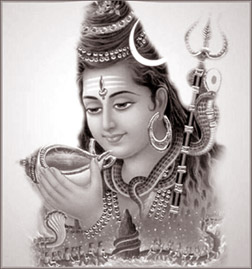 |
|
God Siva |
The Vedic deities symbolize the forces in nature as well as inside
human beings. While discussing the symbolic significance of Vedic
deities in his The Secret of the Vedas, Rishi Aurobindo says that the
gods, goddesses and demons mentioned in the Vedas represent various
cosmic powers, on one hand and man's virtues and vices on the other.
Why worship idol?
Idol worship and rituals are at the heart of Hinduism have great
religious and philosophical significance. All Hindu deities are
themselves symbols of the abstract Absolute, and point to a particular
aspect of the Brahman. The Hindu Trinity is represented by three
Godheads: Brahma - the creator, Vishnu - the protector and Shiva - the
destroyer.
Why worship different deities?
Unlike the followers of any other religion, Hindus enjoy the freedom
of worshipping their personally chosen icon to offer their prayers to
the indefinable Brahman. Each deity in Hinduism controls a particular
energy. These energies, present in man as wild forces must be controlled
and canalized fruitfully to infuse a divine consciousness in him. For
this, man has to gain the goodwill of different gods who stir up his
consciousness accordingly to help him master the different forces of
nature. In a person's path of spiritual progress, he or she needs to
develop the various attributes of these godheads in him or her to attain
all-round spiritual perfection.
Symbolism of Gods and Goddesses
Each Hindu God and Goddess has many characteristics, like dress,
'vehicle', weapons, etc., that are themselves symbols of the deity's
power. Brahma holds the Vedas in his hands, which signifies that he has
the supreme command over creative and religious knowledge. Vishnu holds
a conch which stands for the five elements and eternity; a discus, which
is the symbol of the mind; a bow that symbolizes power and a lotus which
is the symbol of the cosmos.
Shiva's trident represents the three gunas. Similarly Krishna's flute
symbolizes divine music. Many deities can be recognized by the symbols
associated with them. Shiva is often symbolized by the 'linga' or
'tripundra' - the three horizontal lines on his forehead. In the same
way Krishna can be identified by the peacock feather he wears in his
head and also by the prong-like mark on his forehead.
Vehicles of the Gods
Each deity has a particular vehicle on which he or she travels.
These vehicle, which are either animals or birds, represent the
various forces that he or she rides. Goddess Saraswati's vehicle, the
graceful and beautiful peacock denotes that she is the controller of the
pursuit of performing arts.
Vishnu sits on the primal serpent, which represents the desire of
consciousness in humankind. Shiva rides the Nandi bull, which stands for
the brute and blind power, as well as the unbridled sexual energy in man
- the qualities only he can help us control.
In search of the Supreme Being
Trying to perceive God:
From Swami Atma
Every human being is discontented. We all feel that something is
missing. We want more. No matter how much we possess, it is never
enough. We are afraid to die. We want to live longer, be healthier, look
younger and accumulate more wealth. We want to increase our knowledge
and awareness. We want to experience more joy and happiness. All these
lead to unbearable restlessness. Ultimately we're driven towards finding
the ultimate reality. We search for spiritual succor, and we become
conscious about the existence of God - a Supreme Being, who we call
"Brahman."
What is Brahman?
According to the Vedantas, (the end of the Vedas) Brahman is the
'impersonal' God, the Universal Soul, the Supreme Being, and the
Absolute Truth. The philosophy of "Advaita Vedanta" (Advaita means
monism or non-dualism) - based on the interpretation of the Vedantas by
Adi Shankaracharya, who explained the theory of oneness of all creation
- sums up the idea of "Brahman" in three short statements:
 "Brahma SatyamJagan MithyaJivo Brahmaiva Na Parah" "Brahma SatyamJagan MithyaJivo Brahmaiva Na Parah"
This translates roughly as follows:
"God alone is real,The world is unreal,The individual is none other
than God"
The Nature of Brahman: This means that there is only one supreme
reality, a reality called Brahman, the Supreme Being. Brahman is
infinite and omnipresent, therefore nothing can be added to it and
furthermore, there cannot be a place where he is not. Therefore, Brahman
being non-dual in nature, there is no place for the world or man or any
creature outside Brahman. It transcends all pairs of opposites and
descriptions.
The reality of the world is then relative as opposed to the absolute
nature of Brahman. In that sense, and in comparison with Brahman, the
world is unreal. By unreal, it is meant illusory, very much like a
dream, which has its own subjective reality, but which is illusory
compared with the waking state.
The last of the three statements asserts that the true nature of each
individual is Brahman.
Because of "avidya", i.e., our original and inherent spiritual
ignorance, we have forgotten our true identity and mistakenly believe
that we are little, limited individuals.
Describing Brahman: Although Brahman is beyond description, the
"rishis" (seers or sages) of yore declared, based on their personal
experience, that it can best be described as sat-chit-ananda.Sat means
existence pure and absolute.Chit means knowledge, or consciousness, pure
and absolute.Ananda means bliss, pure and absolute.
Our true nature is pure existence, knowledge and bliss. We have this
knowledge deep within us and therefore we cannot settle for being mortal
or experience any type of limitation to our existence, we have an
infinite thirst for knowledge and constant yearning to experience joy.
Perceiving God: A man, let us call him Bob, walks at night on a dark
path. All of a sudden, a snake bites him on the leg. The snake is lying
on the ground just a few feet from him. Lying on the floor, he weeps in
pain, knowing that his life is most likely over. He can feel the poison
traveling in his bloodstream and he cries for help.
The nearby farmer hears him, and comes with a flashlight and points
it to the snake. Lo and behold, the snake turns out to be nothing more
than a rope!
Superimposition: Is Brahman a reality? This analogy illustrates the
concept of superimposition. Bob, due to his fear of snakes, superimposed
a snake upon the rope. He had been touched by a branch, and the sight of
the rope was enough to create the imaginary presence of the snake and
pain of the venom. Now the question is - during the incident, was the
snake real or unreal? The answer is that, subjectively, the snake was
very real to Bob. However, objectively, the presence of the snake was
all illusory and created by Bob's mind.
Similarly, this world has its own subjective reality, but upon
dawning of the knowledge of Brahman, this relative reality subsides and
only the absolute reality of Brahman remains.
In the story, the snake existed only at the time of the incident (the
present), while the rope existed in the past (before the incident), the
present, as well as the future (after the incident).
Likewise, the world exists in the present moment only - although it
is a pretty long moment - while Brahman existed before the creation of
the world, exists in the present, and will still exist forever after the
dissolution of the universe.
Maya Shakti: The Veiling Power: Brahman is both consciousness and
power or "shakti" that operates in many ways. One such power is "maya",
the veiling power, which hides the spiritual truth of the oneness of
consciousness. Maya shakti creates the ignorance of perception of
separateness and diversity of objects in this world.
Courtesy: hinduism.about.com
 |
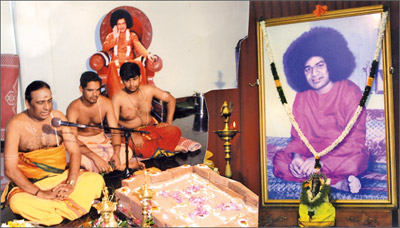 |
| The third commemorative ceremony of
the Chief Trustee Sri Sivasubramaniam Kovil Jeyanthi Nagar,
Colombo late V T V Deivanayagam Pillai took place at Sri
Ramakrishna Mission Hall, Wellawatta, Colombo 6 recently.
Here Head of the Mission, Rev Swamy, Sarua Rupananda Maharaj
lights the oil lamp to inaugurate the ceremony. Chief
Organizer D Easwaran and the Trustee Board Members look on.
Pic A Maduraveeran |
A special Yagna Pooja performed by
Sri Sathya Sai Baba Centre Colombo at the Sai Shrine New
Chetty Street, Colombo 13 recently. The event was organised
to invoke blessing on Bhagavan Sri Sathya Sai Baba. Pic A
Maduraveeran |
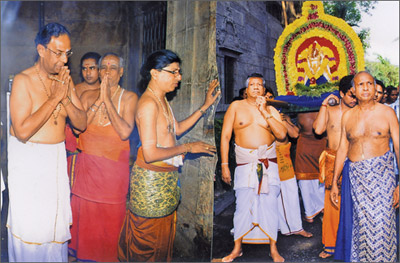 |
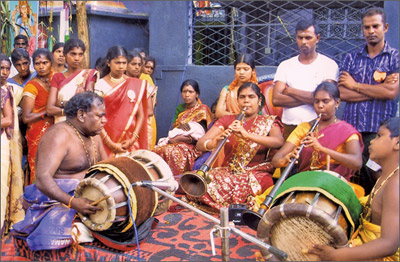 |
| The annual “Ther” Chariot Festival of
the Sri Ponnambala Waneswarar Kovil, Kochchikade, Colombo 13
took place recently. Here the statues of deities paraded
along the streets before being placed on the chariot by
devotees. Pic A Maduraveeran |
A Nathaswara Music Programme of the
Sri Muthu Mariamman Kovil, Unagala, Madolkelle took place
recently at their Warusabiseka Festival. Pic A Maduraveeran |
|



